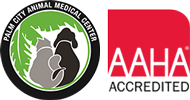Given the number of times you lovingly lock gazes with your four-legged friend, you should easily pick up on their eye issues, right? Unfortunately, ocular conditions can develop rapidly and worsen quickly. What starts as a case of minor tearing and redness can swiftly escalate into a swollen eye, cloudiness, or blood in the eye. By learning how to spot subtle changes in your pet’s eyes, you can get them the immediate veterinary care they need to avoid pain and potential vision loss.
Signs of eye issues in pets
Observing your pet’s behavior and paying attention to changes in their eyes can help you catch potential problems early. Watch for these signs that may indicate your pet has developed an ocular issue:
- Excessive tearing or discharge — Increased tearing or an unusual discharge from your pet’s eyes could indicate an infection or irritation.
- Redness or swelling — Redness, swelling, or inflammation around the eyes may indicate conjunctivitis, foreign material presence, or other underlying issues.
- Squinting or blinking — Pets may squint or blink excessively if they’re experiencing ocular discomfort. They may also be attempting to blink out foreign material or to cleanse the eye.
- Eye color change — Cloudiness or a change in eye color, such as a red, blue, or grey hue, could indicate cataracts, glaucoma, or other serious conditions that affect vision.
- Rubbing or pawing at the eyes — Persistent rubbing or pawing at the eyes suggests irritation or injury.
- Bulging of the eye — An enlarged globe may indicate glaucoma, trauma, or other serious health concerns.
- Vision changes — If your pet begins bumping into objects or having difficulty with depth perception, their vision may be affected.
- Behavior changes — Any changes in your pet’s behavior may be linked to eye discomfort, particularly if they become reluctant to go outside, avoid being petted around the head, or are generally anxious or irritable.
Causes of eye issues in pets
Several factors can contribute to the development of eye diseases in pets, including:
- Genetics — Certain breeds are predisposed to specific eye conditions. For instance, brachycephalic breeds, like pugs and bulldogs, are more prone to issues such as corneal ulcers and prolapsed third eyelid glands (i.e., cherry eye).
- Environmental factors — Allergens, pollutants, and foreign bodies can cause eye irritation and infections.
- Trauma — Accidents or injuries can lead to scratches, corneal ulcers, or more severe eye damage, including proptosis (i.e., displacement) of the eyeball itself.
- Age — Aging pets become more susceptible to conditions like cataracts, glaucoma, and retinal degeneration.
- Underlying health conditions — Systemic diseases such as diabetes or hypertension can manifest in ocular symptoms like cataracts or retinal detachment.
Common eye diseases in pets
While a multitude of eye diseases can occur in pets, some of the most common include:
- Conjunctivitis — Also known as “pink eye,” conjunctivitis is characterized by inflammation of the conjunctiva (i.e., eyelid lining), and results in redness, discharge, and discomfort. Conjunctivitis can be caused by allergies, irritants, or bacterial or viral infections.
- Corneal ulcers — Corneal ulcers are painful sores on the cornea often caused by trauma, foreign objects, or infections.
- Cherry eye — A prolapsed third eyelid gland can appear in the inner corner of the eye as a red bump that may pop in and out of place. Surgical correction is needed to ensure adequate tear production.
- Cataracts — Cataracts cause opacity or cloudiness in the eye lens, which can lead to impaired vision, blindness, or secondary issues, if left untreated.
- Glaucoma — Glaucoma is characterized by increased pressure in the eye that can damage the optic nerve and lead to vision loss.
- Dry eye disease — This condition, also called keratoconjunctivitis sicca (KCS), is the result of eyes not producing enough tears, leading to dryness, irritation, and potential corneal damage.
- Entropion — The eyelids of breeds with excess facial skin (e.g., bloodhounds, mastiffs, Newfoundlands) may roll inward, causing the eyelashes and fur to rub against the cornea. Surgical correction is necessary to prevent permanent scarring.
How to prevent eye issues in pets

Preventing eye diseases in pets involves proactive care and regular monitoring. Here’s what you can do to ensure your pet enjoys good ocular health:
- Schedule routine wellness care — During your pet’s wellness visits, they’ll undergo a thorough physical exam that also focuses on the eyes. Our veterinarian will spot ocular issues that need addressing and provide recommendations for preserving your pet’s eye health. We will also administer vaccinations to prevent certain eye conditions, such as the feline herpesvirus vaccine to prevent conjunctivitis.
- Maintain good hygiene — Keep your pet’s eyes clean by gently wiping away any discharge with a damp cloth and trim fur around the eyes as needed.
- Use protective measures — Use protective eyewear for your pet during activities where they risk eye injury, such as hiking through thick vegetation.
- Seek prompt treatment — Seek veterinary care promptly if you notice any signs of eye problems to prevent complications and ensure timely treatment.
Ensure your pet’s eyes stay bright and shining with love by scheduling regular ocular exams with our Palm City Animal Medical Center team. And, if you spot any eye issues, from excessive discharge to inflammation, contact our team immediately to preserve your pet’s vision.








Leave A Comment